First and foremost, I’m wishing all Cartoon Research friends as happy a holiday season as you could possibly be having this year. Here’s hoping that with any luck and proactive change, the year ahead may be at least a slightly better one. In the meantime, however, perhaps you’ll cheer up with some news that the Cartoons On Film release label has a belated holiday gift for you all! Be sure to read all the way to the end, where I’ll also be sharing a few other updates, as well.
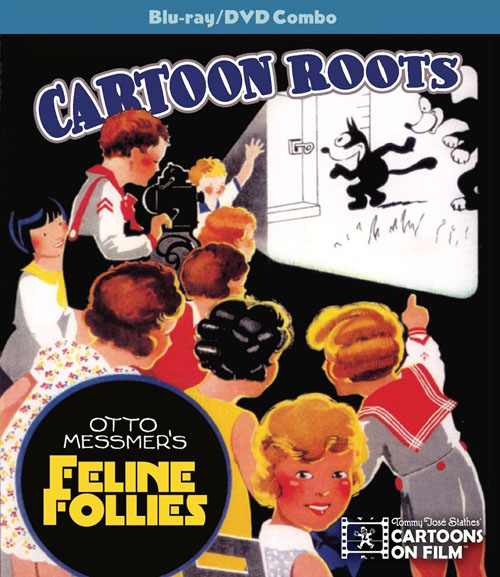
When the original Cartoon Roots Blu-ray/DVD combo was first released some six years ago, it was an exciting moment for me, personally. The home video collection was met with much support from colleagues and audiences alike. While I did not know where this new path of high definition early animation restorations and Blu-ray productions would ultimately lead, I did know one thing all along: this was an important next step in furthering a very long-term goal I’ve always had as an early animation historian and archivist: to not only find more neglected and previously-lost cartoons from the early days, but to do something bigger and better with them than simply watching and keeping them purely for my own personal purposes.
In always having a personal preference for silent era animation, it may go without saying that one of the many foci in my archiving activities has long involved a certain famous cartoon cat from that particular period of film history. By and large, most historians and fans would argue that the two most popular and critically acclaimed cartoon characters from the 1920s, more specifically, were Felix and Koko.

With Fleischer’s clown came newfound ingenuity in animation production techniques through rotoscoping, initially. Fleischer’s Inkwell films also offered wonderful surrealism in visual narratives and an entrancing interplay between a live-action reality and a cartoon world—both of which would seem inextricably linked for a good 6 or 7 nitrate-based minutes on the glimmering silver screen. A magical world, indeed. However, a little black cat, first named Master Tom, would soon prove that it could offer audiences something that Koko could not.
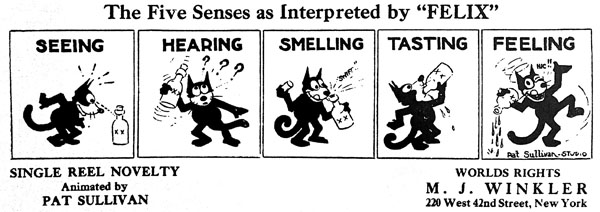
In time, it’s safe to say that this cat would surpass the animated clown both in terms of contemporary popularity, as well as long-term memorability among the general public. Eventually, as master animator and Pat Sullivan Studio employee Otto Messmer would further develop the cat’s personality and design, and a more likable name for it was chosen—Felix—the reasons for this character’s importance would become clearer. Simply put, a combination of elements contributed to this character’s likability: an endearing design, a fully developed psyche with clearly defined personality traits and motives, and expertly executed pantomimic gestures that express to an audience, concretely, exactly what the character is thinking, feeling, and plotting. A lot of high notes were hit in these silent cartoons, and often more so than was being achieved at other studios and in other series at the time—and with such bold, but simple, graphic qualities. Messmer’s craft could be thanked for a great deal of that success.
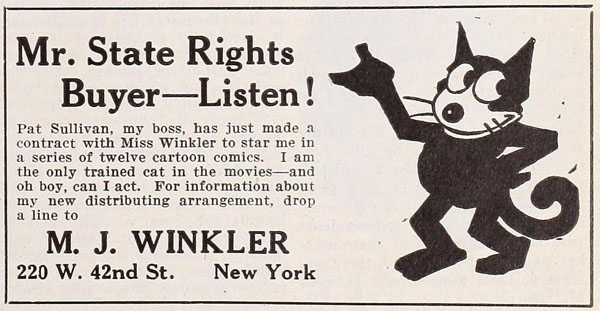
The new Cartoon Roots: Otto Messmer’s Feline Follies Blu-ray/DVD combo chronicles some of Messmer’s early animation work from the late 1910s and through some of 1923. As many readers will know, there’s been controversy as to the issue of who has taken or received credit for Felix’s creation—and who rightly deserves it. While most retrospectives and home video collections of the past have focused solely on Messmer and the Sullivan Studio’s star character, this Roots volume gives some time and space to a few of the pre-Felix films that were created at the Sullivan Studio, prior to Felix, or Master Tom’s debut in Feline Follies (1919). The initial acquisition of these much rarer pre-Felix films, and your ability to see them and study them, offers an unprecedented glimpse into a story that is not exactly so cut and dry, or black and white. In short, some of the pre-Felix films include prototypical black cat characters, and some of these films were animated at least in part by Pat Sullivan, while Messmer was serving abroad in the first World War. By and large, it’s Sullivan’s series of Charlie Chaplin-parodying cartoons of 1918 and 1919 that offer these pre-Master Tom and pre-Felix cat characters for your consideration.
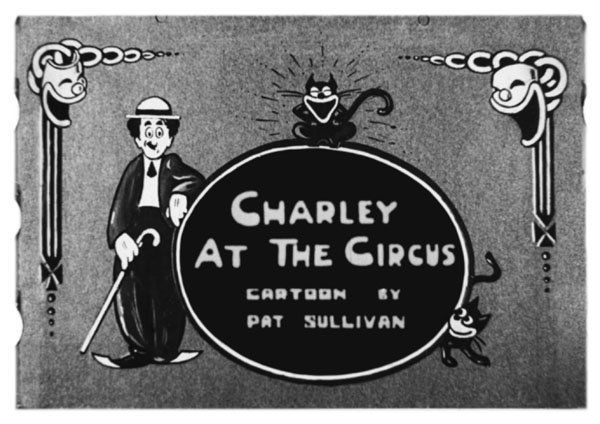
Newly restored title card for a ‘Charley’ cartoon, contained in this new release. Image courtesy of Cartoons On Film.
We’re proud to include two of these ‘Charley’ cartoons in this Cartoon Roots volume. The series’ title cards offer some clues, as you can plainly see. One of these curious cats turns up in Charley at the Beach (1919), which is featured in the collection.
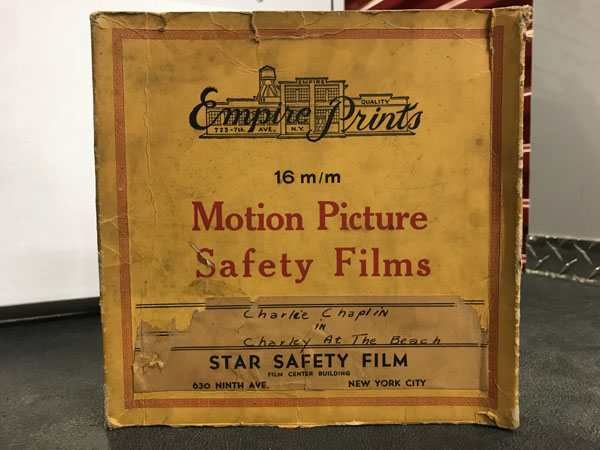
Box containing 1930s 16mm film print of Charley at the Beach (1919)—the rare print used for this new restoration. Stathes Collection.
Next, we move onto that milestone Paramount short, Feline Follies. From that point onward we skip ahead a bit (most of the remaining Paramount-era Messmer shorts are thus far lost!) and focus heavily on several of the earliest shorts that were distributed by M.J. Winkler in 1922 and 1923. You’ve been tempted enough as it is already—so, why not have a look at the trailer for this new release before reading further?
The general public is more familiar with some more decidedly refined and stylized versions of the character which would emerge by the mid-1920s and beyond. As you’ve now seen, the period of 1922 to 1923 as represented here gives us a more dedicated focus on the character’s earlier, more fox or dog-like appearance. While later designs may often be seen as more familiar and more endearing to most, a lot of Messmer’s signature craft and charm is fully evident here, and we see the foundation being formed for what would become the first animated cartoon superstar. Regardless of the gray area that was the character’s initial development, one thing becomes obvious and true: it was largely Messmer’s mind and hand that would be responsible for developing this cat, and its amusing narratives, in a way that so many people still love and admire a century later.
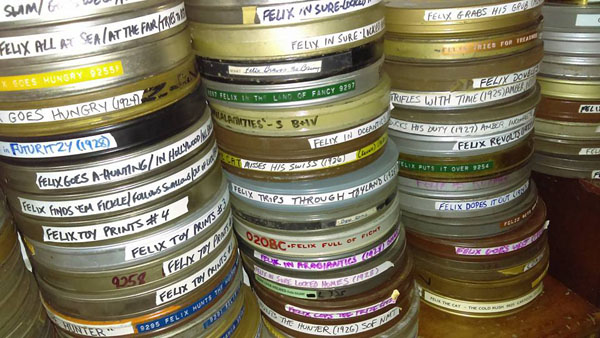
A small cross-section of silent 16mm Felix cartoons in the Stathes Collection
It will be up to you to ponder Felix’s merits further, at least in terms of character development and film narrative. When I approach this work as an archivist, my concern centers largely around the age of the films and their availability. How were they handled over the decades, and by whom? Felix turned 100 years old last November, and most readers already know that silent films do not have a promising survival rate. What’s especially true of a large number of the silent Messmer films is the fact that so many of them have fared poorly over the decades, existing or circulating only in poor copies, and with many currently considered completely lost. Formerly unavailable titles do turn up from time to time, and seeing that process unfold is one of the more exciting parts of my work as an archivist. Being able to present these rare films to you in this way is an even more gratifying and fulfilling experience.
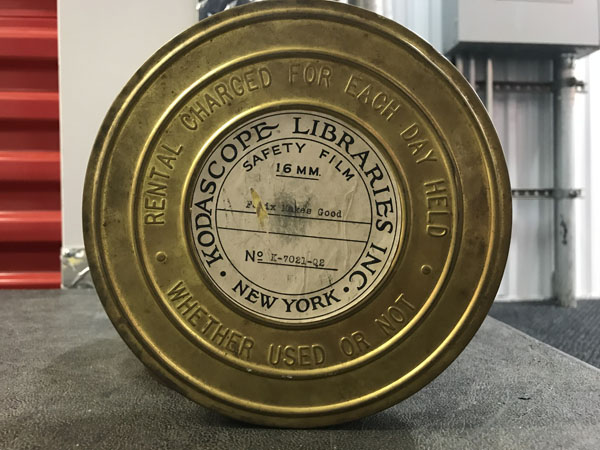
A 1920s 16mm Kodascope print. Stathes Collection.
One significant element that has enabled this project is a type of film print that we collectors and archivists lovingly refer to as ‘Kodascopes.’ Back in the 1920s, as the 16mm film gauge was growing in popularity, the Eastman Kodak company founded a rental library aimed at providing consumers with licensed prints of famous theatrical films, and educational shorts, that could now be shown in someone’s home, so long as they had the space and money to either buy or rent a 16mm film projector, and the wherewithal to rent prints for showing at home. Schools, churches, libraries, and other organizations would also partake in these rentals, whereas 35mm projection was more cumbersome, more expensive, and often dangerous, if nitrate film was being used for presentations.
The 16mm gauge really opened up a whole new world of possibilities for non-theatrical film showings, and the incredible thing about the Kodascope Libraries prints is that they were made from 35mm negatives. The resulting quality was stunningly sharp. Some cartoons of the 1910s and 1920s were also given this Kodascope treatment, and that includes a large number of Felix cartoons. These prints are somewhat rare, and sometimes they are quite worn when they turn up. They’re now almost a hundred years old. However, some of them are titles that were never distributed again beyond that point, and the picture quality is often gorgeous, especially if the print is not too worn. I’ve spent the past 15+ years trying to find these kinds of Kodascope prints, and several of them have served as the basis for the restorations in this project. I know you’ll be quite pleased with the results. Some of the films will almost look too good to be true, since we’re used to seeing them in murky, dupey, worn copies…but no, these cartoons really did look perfectly clean and sharp when they were first released, and even when they were first printed in 16mm.

A rare behind-the-scenes look at one of the Kodascope Pathescope Libraries
and their massive collections of superior film prints.
For an example of what we’ve achieved, have a look at the below before-and-after comparison. You’re seeing a single frame from one of the cartoons in this collection—on the left, the version that most of the general public has seen for decades, after it was duped in an inferior way for inclusion in a 1950s television package. On the right, the same frame from our restored version, which was sourced from an earlier 16mm print that was a few generations closer to 35mm master materials. I think the difference is obvious, and I’m glad an old problem has been corrected somewhat. These cartoons deserve nothing less.
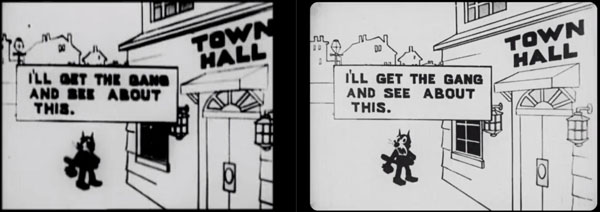
Commonly circulating version of Felix Revolts (1923) on left; on right, Cartoons On Film’s new restoration
While some of the titles in this new collection are quite rare and generally unknown to others in our circles, some of them are more common titles—but now available in these superior versions. Some of these films have cropped up in many different ways over the years (see 8mm “home movie print” below, of the same short in the image above!) and my hope is that we’ve now presented what may very well be the best possible versions ever…that is, unless original 35mm nitrate prints will still turn up someday. You never know. It’s always possible.
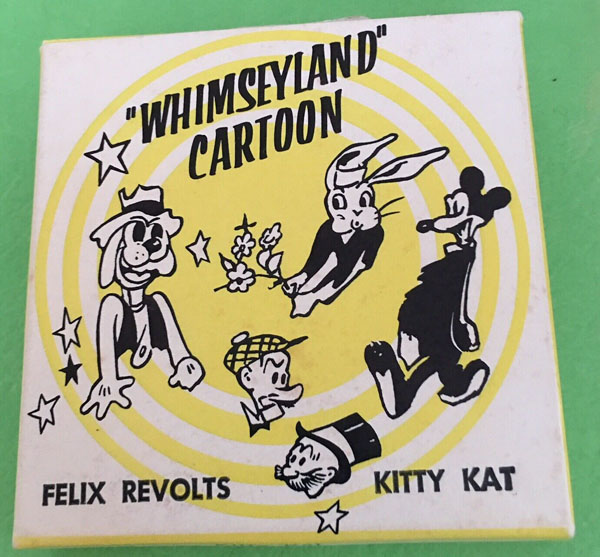
Shortened 8mm film print of Felix Revolts (1923), marketed in the 1960s for children’s home projection
There are many people to thank for their contributions to this project, and they know who they are. You’ll see most of them listed in the video credits and liner notes of this new release. If you like this character, want to see more of this studio’s early films, and want to support restoration efforts such as this, simply buy the collection. It’s now available on Amazon!
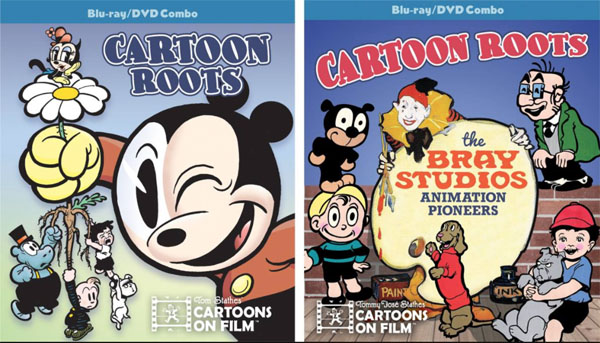
In other *good* news, check it out: the original Cartoon Roots and Cartoon Roots: The Bray Studios—Animation Pioneers collections are now both back in print, after a long hiatus. I’ve also reworked Amazon offerings so that customers can finally batch multiple Roots volumes in a single order, with a combined shipping rate. Finally…watch this space soon, about a couple of weeks from now, for some exciting news about an entirely new Cartoon Roots project in the works. Hint: we’ll need every reader’s help to pull it off. Get ready!
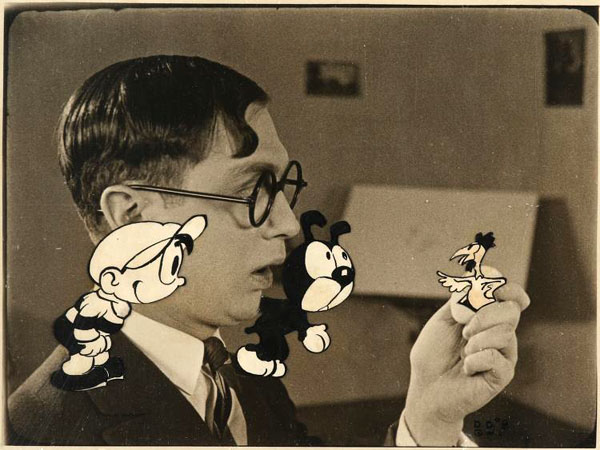
In the meantime, wishing you all a happy and healthy new year ahead.


 Tommy Stathes is an animation historian specializing in silent era cartoons. He resides in New York and frequently holds public screenings throughout the city. You can read more about his work, his collection and his research on his website:
Tommy Stathes is an animation historian specializing in silent era cartoons. He resides in New York and frequently holds public screenings throughout the city. You can read more about his work, his collection and his research on his website: 
















































Great news, Tommy.
I will order this in the next couple of weeks.
I immediately recognised those scenes from “Felix Wins Out” in the trailer — and in such a beautiful, clear, amber-tinted print! Sold! I hope the next few weeks fly by, because I can’t wait to see this collection. Happy New Year, Tommy!
I can’t wait to see these gorgeous remasters of early Felix cartoons! Great job, Tommy!
And it appears you’re going to put out a set of Walter Lantz Dinkie Doodle cartoons next! This is bound to be a great set, too! And I hope it comes out quickly! Best of luck!
My copy was shipped Christmas Eve, so it looks like I’ll be starting the new year off on the right foot… er, paw. I really appreciate the obvious care and work that go into these Cartoon Roots productions. Glad to see them continue, and I’m eager to see what comes next.
BTW, the photo in the article seems actually to be a Pathescope library as seen here:
https://www.cmstudies.org/page/groups_nontheatrical
Thanks Tommy!
Just ordered mine this morning! Keep up the good work, Tommy!
Perhaps the Messmer/Sullivan controversy is a bit like that regarding Batman’s: Bob Kane can technically be credited with creating the character, but Batman wouldn’t have amounted to anything without the input of Bill Finger, along with the later artists who worked on the character, like Jerry Robinson and Dick Sprang. Perhaps Sullivan was involved in creating a cat character inspired by Chaplin, but without Messmer–who combined the talents of a Finger and Sprang, and like them worked as a ghost–Felix would never have become what he is.
Anyway, I am delighted by the news of this set and ordered it the second after I received news of its release. Everyone else should to!
Great works!! Thanks, Steve!!
Great stuff Tom! keep up the great work.
Kudos Tom.
Great work! 🙂
No i mean, Tom, not Steve. Sorry.
Ordered my copy Christmas Eve, thanks for all the hard work, Happy Krimble and a Happy New Year!
Many thanks to everyone who has ordered so far! Cartoons On Film wouldn’t be able to do what it does without your support.
P.S. to Paul Penna…I can’t seem to reply under individual comments anymore, no matter which browsers I try on my phone or laptop. Anyway, good catch re: that photo. It was sent to me awhile ago without the surrounding info and seemingly misfiled here. Perhaps our webmaster can correct the caption and note that Pathescope was similar to Kodascope…
Tommy – Replying to individual comments is temporarily disabled. It’s a glitch that will be fixed in the new year.
Also, caption corrected.
Interesting cartoons.
Just ordered Felix and just backed Dinky Doodle! THANK YOU SIR!!!!!!!
I ordered this disc, and I’ll have to look some of the other titles up as well. These early silent shorts are fascinating as not just film history but to study how animated cartoons developed over the years.
I just bought the ‘Cartoon Roots’ since I am a big fan of silent film Felix. So I bought I watched all the DVD episodes since I only have DVD not Blue ray. But I see you have some films that never made it to the DVD set. Some of these silent film’s of Felix Ive only heard rumors about. Like I only seen a blurry version on Youtube of Felix in Toyland. I have a big question, Is there any chance I will ever see these films of Felix I so badly want to see? Im willing to pay if I can just see a glimpse?
Ive been a fan of Felix ever since I was a little kid in the 90s but I only like the 1930s Felix not the 1960s. But late I found the twisted Tales of Felix but I still felt like there was something missing. And I felt like the Felix movie was a disappointment. Even the 2003 Christmas Felix was creepy. But later when I became a Teenager in 2003 I found a DVD of Felix at the dollar store I bought the DVD thinking I could finally have my favorite 1936s Felix the cat goose that laid the golden egg. earlier I could only see the Felix VHS at my grandmas. This way I would have my own version of Felix. Later my sister told me there was more to the Felix DVD. that the DVD had Felix silent Films! ever since Then, Ive loved the Silent films of Felix. My favorite silent film of Felix being ‘Felix Gets the Can (1925)’ since Ive always wanted to go to Alaska. Im also a artist who draws Felix for fun. check my instagram for my Felix fanart! https://www.instagram.com/boxcarmarbles/